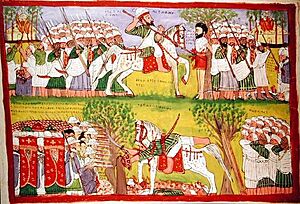Ethiopian–Adal War facts for kids
Quick facts for kids Ethiopian–Adal War |
|||||||||
|---|---|---|---|---|---|---|---|---|---|
| Part of the Somali–Portuguese conflicts, Ottoman–Portuguese conflicts (1538–1560) | |||||||||
 Early 20th century folk drawing of Cristóvão da Gama and Imam Ahmad's deaths. |
|||||||||
|
|||||||||
| Belligerents | |||||||||
| Commanders and leaders | |||||||||
The Ethiopian–Adal War was a big fight between the Christian Ethiopian Empire and the Muslim Adal Sultanate. It lasted from 1529 to 1543. In Arabic, this war is called Futūḥ Al-Ḥabaša, which means Conquest of Abyssinia.
The Ethiopian army included people like the Amhara and Tigrayans. Later in the war, the Portuguese Empire sent about 400 musketeers to help them. The Adal forces were made up of Somali, Afar, and also Arab and Turkish fighters. Sometimes, mercenaries called Maya fought for both sides.
Contents
Why the War Started
This war began because of a powerful leader named Ahmad ibn Ibrahim al-Ghazi. He was a military leader from the Adal Sultanate. Between 1529 and 1543, he led a huge campaign. His goal was to take control of the Christian lands of Abyssinia.
Imam Ahmad's army was made of Afar, Harari, and Somali fighters. They almost completely took over the old Ethiopian kingdom. But the Ethiopians got help from Portugal, led by Cristóvão da Gama. This help allowed Ethiopia to stay independent. Both sides used up a lot of their people and resources in this long war. This changed the power balance in the region for many years. Some historians believe this war is why Ethiopia–Somalia relations have been difficult.
Key Events of the War
Early Victories for Adal
In 1529, Imam Ahmad's Adal troops won an important battle. They defeated a larger Ethiopian army at the Battle of Shimbra Kure. The Harari cavalry played a key role in this victory. They were very skilled at outmaneuvering the Ethiopian soldiers.
Adal had even bigger wins in 1531. The first was the Battle of Antukyah. Here, cannon fire at the start of the battle scared the Ethiopian soldiers. The second big win was the Battle of Amba Sel. In this battle, Imam Ahmad's troops not only defeated the Ethiopian army but also scattered them. They even captured important items belonging to the Ethiopian Emperor.
These victories allowed the Adal army to enter the Ethiopian highlands. They started to burn and destroy many churches. One famous church they attacked was Atronsa Maryam. This church held the remains of several Ethiopian Emperors.
The Siege of Aksum
Imam Ahmad continued his march, defeating armies in Agame and Tembien. He then moved towards Aksum, an ancient and important Ethiopian city. He wanted to capture Aksum to strengthen his control over Ethiopia. The local people of Tigray gathered to defend their holy city.
Even though they fought hard, Imam Ahmad's forces defeated them. Many Christians were killed. One historian, Arab Faqīh, said that over 10,000 Christians died. When Imam Ahmad reached Aksum, he besieged the city. During the Siege of Axum, he destroyed the Church of Our Lady Mary of Zion.
Portuguese Help Arrives
The Ethiopian Emperor Dawit II died in 1540. His son, Prince Menas, was captured by Imam Ahmad's forces. The Empress was trapped in the capital and could not help.
In 1541, the Adal forces first met Portuguese soldiers. These Portuguese soldiers had been stranded in Massawa after a battle with the Ottomans. The Adalites ambushed them at the Battle of Massawa (1541).
In 1543, a smaller Ethiopian army, with help from the Portuguese, defeated a larger Adal-Ottoman army. The Portuguese sent 400 musketeers, led by Cristóvão da Gama. They arrived by ship through Massawa, an important port in what is now Eritrea. However, Da Gama was captured in the Battle of Wofla and later killed.
The Final Battle
The Portuguese musketeers were then led by Bahri Negassi Yeshaq, a local king. Yeshaq helped the Portuguese with supplies and information. He also joined Emperor Gelawdewos and the Portuguese in the final, decisive battle. This was the Battle of Wayna Daga.
Tradition says that Imam Ahmad was shot in the chest by a Portuguese musketeer named João de Castilho. The Imam was then killed by an Ethiopian cavalry commander. When Imam Ahmad's soldiers learned he was dead, they ran away. His death and the victory at Wayna Daga caused his forces to collapse. The Adalites were forced to retreat from Ethiopia.
After Imam Ahmad's Death
After Imam Ahmad died, his nephew Nur ibn Mujahid became the new leader of the Adal forces. He married Bati del Wambara to strengthen his power. In 1559, Emir Nur's cavalry defeated and killed Emperor Gelawdewos in battle. They also sacked the Ethiopian town of Waj.
At the same time, an Ethiopian general named Ras Hamalmal attacked the Adal capital, Harar. He captured Sultan Barakat ibn Umar Din and executed him. This ended the Walashma Dynasty. Some historians believe Sultan Barakat was returned to Adal in exchange for Prince Menas. Emir Nur showed Emperor Gelawdewos's head in Harar to celebrate his victory.
Later, in 1577, Emperor Sarsa Dengel defeated and executed Sultan Muhammad V. He was succeeded by Imam Muhammad Gasa, a relative of Imam Ahmad. The capital of Adal moved to Aussa. The capital of Ethiopia moved to Gondar.
Impact of the War
The Ethiopian–Adal War was very destructive, especially for the Harari people. Many people died, and their population decreased a lot. Some historians believe that because both sides were so weakened by this war, it created an opportunity for the Oromo people.
The Oromo were able to migrate and conquer new lands. They moved into areas like Welega, south of the Blue Nile, and eastward towards Harar. This led to the creation of new territories for the Oromo people.
See also
- Ajuran-Portuguese wars
- Ottoman–Portuguese conflicts (1538–1559)
- History of Somalia
- History of Ethiopia
- Ethiopian–Somali conflict
- Battle of Hubat

